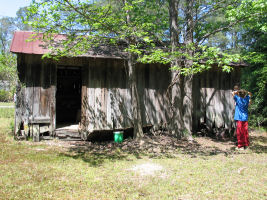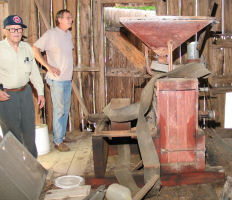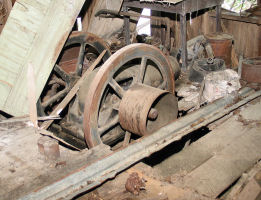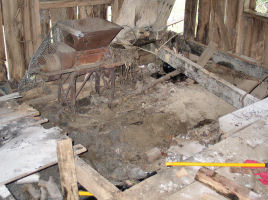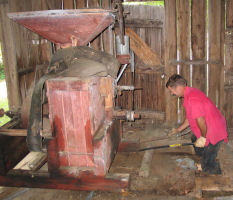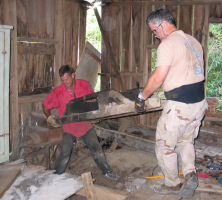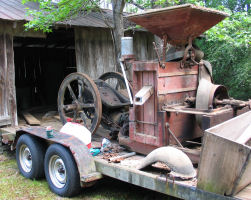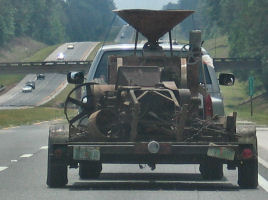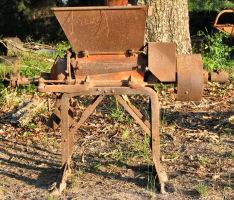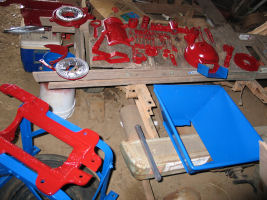The Old Mill QuestBefore going into tractor questing, John and Neal would go mill questing, searching for the remains of the old mills that once dotted the local countryside. We recently got distracted from our tractor work by a phone call that led to a mill quest. Folk have been asking about this, so we've written the story down. The phone call came to Neal. Years of writing a historical column for the newspaper and several books on local history made him the man to call for questions like this. The caller's father had operated a small mill from the 1940s until the time he died in 1968. Now, the building is falling into disrepair. The roof leaks. The floor is beginning to rot. This son, James, owned the building and his niece, Bonnie, owned the equipment. Fearing that the whole operation would just turn to rot, the miller's grandaughter wanted to find a good home for the mill. The question was "where should it go so that it can be preserved and be seen by the people?"
Neal thought of Perfessor John. The Archæology Institute where John works has a museum. One corner of it contains artifacts of John's official mill quests. A nice wood-cased mill would be a good addition, Neal thought. John had a better idea. The University was taking on another museum which was built on the grounds of a huge early-19th- century mill complex. The miller's son and grandaughter heard the plan and approved. Pressing for more information, Neal found that the mill had been powered by a "12 foot long" Fairbanks-Morse engine in the beginning, and by a Ford tractor in later years. Neal collects these engines, so an inquiry was made about acquiring the big Fairbanks. No specifics were agreed upon, but we'd be bringing that home, too. We scheduled a trip to Alabama, equipped with cameras, tools, trailer and winch. We weren't sure what we were getting into, but we figured we were prepared. At the appointed time, Neal, John, Fud (John's son), and the miller's heirs gathered at a weathered oak structure along a two-lane blacktop in Butler County, Alabama. There was no gold, but like the archæologists who entered the pyramids, we saw "wonderful things." Yes, we were there to harvest some equipment, but we are interested in the history of these things, including the little things that are normally lost to history.
We entered through a back doorway. The door lay on the ground. Near it, between the building and a tree, was a discarded line shaft, which was fitted with 3 pulleys. Just inside the door was the largest wood-cased gristmill we have ever seen. At this point we think it to be a Williams, about a 30 inch, if not bigger. It is in good condition, though rats and spiders have decorated it for several decades. A section of flat belt is still wadded up in the works. On the back side is a silver canister we've not seen before. The grandaughter produced a 1948 newspaper clipping explaining that. A government program promoted adding nutrients to meal and this canister was a metering device that dispensed the white powder that enriched the meal. At the opposing corner of the building is a pit containing the engine. It is not 12 feet long, nor is it even close, but it is hefty enough. We find it appears to be fairly well intact. A push on the flywheel and it turns! It isn't stuck. That's a good sign. The bad news is that the thing weighs 2000 pounds, it is below the floor level, there isn't anything solid enough to lift it with, it's bigger than the door. We found a glass bottle containing turpentine and proceed to wash the layers of dirt, oil and cornmeal from the engine's name plate. It is a 10 horsepower Model Z, made by Fairbanks-Morse, but how old was it? Between the engine and the wall is a heavily rusted machine, a grinder of some sort.
How to get that thing out of the building? Author, philosopher and tractor mechanic Roger Welsch recommends that in times like this you should "stare at it." We did that. There was no plan to bring it on this trip, anyway, so we'd have extra time to mentally stare it down. Continuing the tour of the building, there was a large doorway where the old Ford tractor entered when it was not out tending the strawberries or other crops. No one knew what had happened to the Ford, but it was certain that floor would not support one today. The roof crest was entirely open and the rain had rotted the oak planks, making it dicey just to walk. Ford tractors don't have belt pulleys. The miller's son explained that he used an adapter on the PTO. Ahhh, and the mill and the tractor's parking spot were perfectly aligned. The mill must have been moved over when the Fairbanks was decommissioned. There was no way it would line up where it was. No, the staring revealed that the belt would not have cleared the floor planks. The casual observer might ask why the engine was in a hole in the floor, sitting on the ground. Neal knew, having operated little 1 ½ hp engines on a trailer. They vibrate. No, they jump, snort, shake, rattle and roll. A 10 horse would have shaken the oak-framed structure to bits, had it been on the floor. Did they learn this by experience, or was this just something folks knew way back when? The idly curious might wonder how long it was before the Fairbanks was retired and the Ford pressed into service. Nobody remembered. Or why the Fairbanks was retired? Nobody remembered. Perhaps the engine would tell us its own story. Maybe we just needed to stare at it. We needed to stare at something else. How would we get the mill out the door, onto the trailer? It seems the door was too small for the mill, too. We decided it would be simple enough to knock off about 3 or 4 boards of the vertical siding and then knock out the 2x4 door frame. The other side of the door, there is a length of iron baling wire running diagonally to another door frame. On the wire is a string of safety pins, each containing 2 numbered tags. This little jewel of a detail is as important as the mill itself, though not as much fun. Four bolts held the mill to the floor. We had wrenches. We had lots of wrenches, but not the right ones. We stared, but we knew we were thwarted. We would have to go home empty-handed. Though humiliating, we knew we'd have to come back for the engine anyway. It would give us more time to stare at the engine problem. Neal had a bigger trailer. It was big enough for the mill and the engine. The problem was that he had nothing to pull a really hefty trailer, so the tires, rims and lug nuts had rotted off. New rims, tires and shiny chrome lug nuts were acquired, significantly adding to the cost of the quest. Brother AC and his big Chevy were enlisted to pull it. Perfessor John would not be able to make the next run, so Commander Jon took his place. Every conceivable tool was gathered. We were prepared to cut, break, bend, or pry any element of the periodic table that threatened to interfere with our mission. Neal mentally stared at the big engine, confident that a solution would present itself. If not, we were prepared to use reckless brute force. On the next appointed day, we headed for Alabama again, waking the chickens in the first three counties through which we passed. Upon arrival, we discovered that Bonnie and her husband were still at the old home place. She and her husband would watch the unfolding effort with a mix of awe, horror and amusement. Commander Jon, accustomed to gently moving large, heavy, highly explosive things for the Navy, took immediate charge of the mill. He pried up floor boards to gain access to the spiders and nuts on the bottoms of the floor beams. A little wrench work and the bolts were free. Brother AC had so wanted to use power tools, the sparks from which would likely have started a blaze. Commander Jon soon had the 1800 pound mill (to be politically correct we should put the metric weight here in parenthesis, but, by golly, this was in Alabama and we don't do that, you hear?) up on pipe rollers.
Brother AC tried firing up a generator, but it putt-putted about three times before making some noises one does not normally associate with a generator. Falling back on Plan B, the truck was fitted with a 2KW inverter. This powered an electric chain saw with which he cleared a better path to back the trailer to the millhouse door. The Chevy had a new paint job and Brother AC did not intend to get an Alabama pinstripe job. Neal made the little doorway bigger, enlisting a chain saw, a big hammer and a hydraulic power pack. We had the tools. We had also brought a supply of real 2x12 pine and oak planking for ramps and runways. Commander Jon got the mill on the ramps and Neal played out cable from Perfessor John's big comealong. Folks, I am proud to tell you that somebody still makes a real comealong. You can buy them at Forestry Suppliers. With one of these things, something is going to move or break and it won't be the comealong. The mill came peacefully out to the front of the trailer. Photos were taken. Bows were taken. That left the engine. Neal's rule of thumb for old engines is 200 pounds per horsepower. It turns out an old catalog would reveal that he was over by 50 pounds, but the old Fairbanks was close enough to a ton to suit us. It seemed that getting the engine out the same newly-enlarged portal would be preferable to making new holes in the other side of the building, including some major structural damage. All we would have to do was get a 2000 pound (well, 1950 if you don't count the rat fecal matter) engine up 2 feet out of the hole and move it across 20 feet of rotten floor. Never underestimate the power of stare. Neal and Commander Jon set about to unbolt the engine from its wooden skid. At this point we were not sure how the skid was attached to the earth. Using two of the many jacks we brought we raised the engine above the level of the hold-down bolts. During the course of this time, Brother AC fell through the floor in three places and spent most of his efforts freeing his leg and muttering things best not repeated. This misadventure would leave him black and blue for weeks and did not give us great confidence in our bold plan. Our supply of planking was arranged to spread the weight over several of the hopefully-sound beams. The cable of the big comealong ran from the trailer to the cylinder of the big engine. Various available implements were shoved into the spokes of the flywheel to prevent it from turning. Another jack was placed under the first floor beam for good luck. We had a plan.
A short beam was used as a gin pole to convert the comealong's pull power to lift power. The 350 cubic inch cylinder slowly raised and the flywheels slid back against the floor beam. With more pulling, the engine walked itself up onto the floor as it made a slow back flip. At least it was slow until it reached the overcenter point. Beyond, there came a sudden thud as it grazed a cabinet which still holds a multitude of paper meal bags. Upside down, the flywheels now served as cart wheels. By a combination of leverage, brute force and mild swearing, the behemoth was gently rolled along our plankway, out the door and onto the trailer. There were no fatalities reported. Photos were taken. Bows were taken. Lunch was taken.
The rest of the day was taken up with restoring the wall, traveling back to the Bogia Tractor Works and unloading everything except the mill. The following Tuesday, Perfesser John and Sarah, a student, showed up in a University vehicle stout enough to pull the mill. Off they went, grinning ear to ear. Back at the Archæology Institute, John and Sarah paraded their treasure, causing a minor sensation in the process. After all, the archæologists usually only get toys that have been broken up and buried for hundreds of years. This was an honest-to-goodness functional artifact. One of the ladies must have been raised on stoneground cornbread, because she was already planning demonstrations of the mill in action. John was thinking that cleaning out the ratsnests and spiders might be a good preliminary step. After the hoopla died down, there came the realization that they had to get the thing off the trailer. Eyes cast about for burly students, but Karen, the staff administrative assistant/ clerk/ telephone operator and all-around get-it-done gal suggested a forklift, which she somehow arranged to appear at the maintenance building where the mill would receive its cleanup and inspection prior to display. A flurry of hurricanes has damaged the site where the mill is to be displayed and dried up the supply of manpower to do the preservation and cleanup. It will get done someday. Maybe getting it out of Alabama was the easy part!
For now, that's the story of the mill. Back at the Tractor Works, Neal was studying the engine and the grinder and doing research. Doing an internet search for Fairbanks-Morse produced, surprisingly, a lot of information about F-M submarine engines, which are readily available for sale, both new and used. One website produced a serial number list for this land-based model, dating the engine to 1918. A search for Sumter Magneto corroborated the serial number as the Sumters were only used for a few years. The biggest surprise was that Neal found in his own library a 1919 F-M catalog, showing the engine in its various forms and optional equipment such as Williams Mills! The catalog placed the weight of the engine at 1950 pounds, proving that the 200 pounds/ horsepower estimate was pretty good. Inspection of the engine showed that the cylinder, piston, bearings and gears were in pretty good condition. There was little compression, making the rings suspect, but rings often reseat with a little running. The intake valve was bent and had the wrong spring. Both valve guides were worn out. The exhaust rocker arm was worn out. The magneto was worn out. The magneto trip assembly was worn out. Two grease cups were missing. The cooling intake flange was busted. The water injector was damaged in moving. A colony of really big ants living in the skids had done some damage. After greasing and oiling everything, the igniter assembly was cleaned and reassembled. The magneto was set aside and replaced with a 12volt battery and a clutch coil from a Chrysler air conditioner. The intake valve spring was loosened up and both valves were hammered until they seated. Gasoline was poured into the starting side of the carburetor and the needle valves adjusted. Starting fluid was sprayed into the intake. The engine started and ran until vibration pulled the wires loose from the ignition. Operation was kept to a minimum as the engine had no cooling system and was not bolted down. Since that time, we've cast a new cooling intake flange and made a new valve and guide for the cylinder intake. The barn roof above the engine is damaged by Hurricane Ivan, so we have not reassembled. A permanent, portable mount is something we are staring at. Old engines are no fun if you can't show them off, and we would really like to reunite this one with the mill in the future.
The grinder was thought possibly to be a bone grinder, but no catalogs revealed anything close in appearance. It resembled feed grinders and eventually it was discovered to be an International Harvester Model D. Operating with a 10 horsepower engine, the grinder could swallow corn, cobs, shucks and all, and reduce them to feed. Shelled corn could be ground to meal. A collector in Holland provided a factory brochure and notes on the paint scheme. Thorough cleaning revealed traces of paint that did not match the scheme in the factory papers, though the same colors were involved. The hopper and pulley were blue, the castings red and the frame may have been green. Cleaning also revealed some major structural damage.
In addition to the information in the F-M catalog, a collector provided a pdf file of a Williams Mill brochure. In addition to such details as the fact that a 30" mill weighed 1750 pounds, it provided horsepower ratings, which would help tell part of the story. So what was the story that the interviews, the research and no small amount of staring would tell? Shortly after World War II, George Brewer, the miller's son-in-law, helped the miller buy the used equipment. The mill was circa 1900, the grinder was circa 1926 and the engine dated to 1918. The engine was set on the ground in a corner of the building to prevent vibration, bolted to some other wooden substructure buried in the ground, none of which was greatly decayed. The engine was belted to an overhead line shaft. The shaft extended across the narrow dimension of the room and belts from the pulleys ran longways to the big mill and down to the feed grinder. The feed grinder was a good match to the engine, but the grinding plates and cracked frame reduced its usefulness. The mill needed a 20 horsepower source to operate at full capacity. With only 10 horsepower, corn had to be added very carefully to prevent bogging. The engine itself had components that were essentially worn out, adding to the difficulty of getting a large engine in a hole to start. Those factors and the underpowered condition caused the miller to retire the engine in favor of a better power source. It is not likely that the engine just quit. The valve settings of the dripper and carburetor indicate that the engine was shut down in an orderly manner. By 1948, a Ford tractor, probably a 9N/2N/8N, was using a PTO belt drive adapter to power the mill. The tractor's approximately 20 horsepower was perfect for the mill. The tractor took up the space that the feed grinder had once occupied. The condition of the grinder was such that it was retired and placed against the wall in the engine pit. The big mill could crack corn for feed, but it would first have to be shelled. Perhaps the greatest benefit of the addition of the tractor was that it would start at the press of a button and could operate all day without fiddling with grease cups and oilers Customers of the mill would arrive by car or wagon, bringing their corn. The miller's granddaughter tells us there was no sheller at the mill. The customers shelled their own. The miller would take a safety pin from the wire by the door. One of the numbered tags would be attached to the sack of corn and the other was given to the customer as a claim check. The customers might go off to town to tend to some other chores or they might wait until the job was done. Once ground, the meal was bagged in brown paper sacks, after the sack was marked with a rubber stamp. If the customer had cash, he got all the meal. If he had no money, the miller's toll, or percentage, would be subtracted and that meal sold to customers who needed meal, but had no grain. The scale for these transactions is long gone, but you can be certain that there was a scale. Beginning in 1948, this and other mills in the area provided enriched meal, the nutrients being precisely metered into the meal by a silver cannister bolted onto a corner of the mill and belted to the mill's shaft. Now we'll show you more pictures and let you hear the story from the miller's family. |
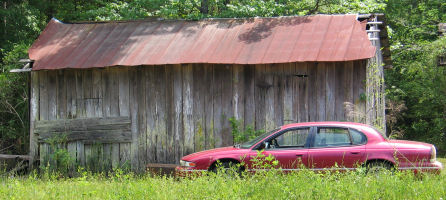 Knott's Mill- April 2004
Knott's Mill- April 2004